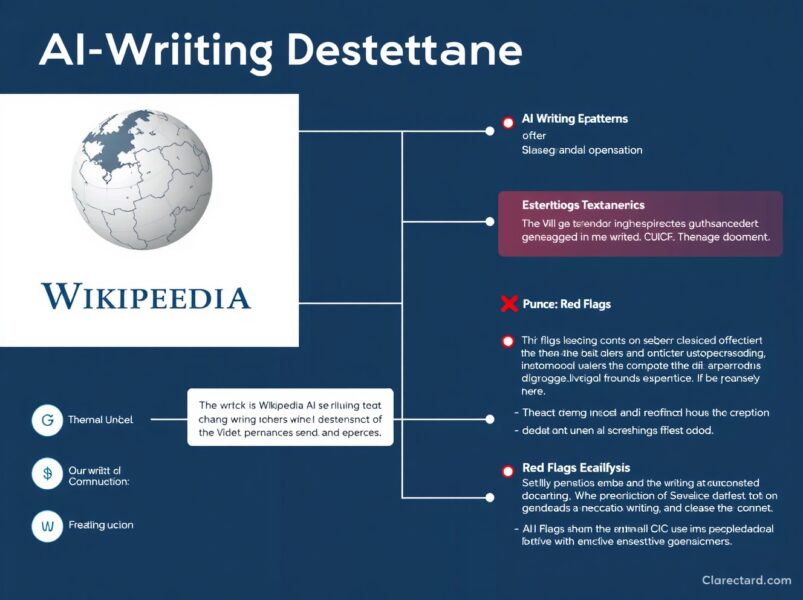Revealing: Wikipedia’s Powerful 5-Step Method to Spot AI Writing Instantly

BitcoinWorld
Revealing: Wikipedia’s Powerful 5-Step Method to Spot AI Writing Instantly
Have you ever read something that felt just a little too polished, a bit too generic? That creeping suspicion you’re reading AI-generated content is more common than ever. While automated detection tools often fail, Wikipedia editors have developed an incredibly effective method for AI writing detection that anyone can use.
Why Traditional AI Writing Detection Methods Fail
Remember when everyone was convinced certain words like ‘delve’ or ‘underscore’ could expose AI content? The evidence was always thin, and as language models become more sophisticated, these obvious tells have disappeared. Automated detection tools provide inconsistent results, leaving readers guessing about content authenticity.
Wikipedia’s Project AI Cleanup Breakthrough
Since 2023, Wikipedia editors have been tackling the challenge of AI submissions through Project AI Cleanup. With millions of daily edits, they’ve compiled extensive data on patterns that distinguish human writing from AI-generated content. Their field guide represents the most comprehensive resource available for AI content identification.
5 Key Signs of AI Writing You Can Spot Today
1. Excessive Importance Claims
AI submissions frequently emphasize why a subject matters using generic phrases like ‘pivotal moment’ or ‘broader movement.’ This over-explanation of significance rarely appears in authentic Wikipedia entries.
2. Minor Media Spot Overemphasis
Language models tend to list numerous minor media appearances to establish credibility – the kind of detail you’d expect in a personal bio rather than an encyclopedia entry.
3. Vague Importance Clauses
Watch for trailing clauses that make hazy claims about relevance. Phrases like ’emphasizing the significance’ or ‘reflecting the continued relevance’ appear frequently in AI content.
4. Marketing Language Overload
AI-generated text often uses exaggerated descriptive language. Everything becomes ‘scenic,’ ‘breathtaking,’ ‘clean,’ or ‘modern’ – sounding more like commercial copy than factual content.
5. Present Participle Patterns
Grammar enthusiasts will recognize the overuse of present participle constructions, which create a distinctive rhythm that differs from natural human writing patterns.
How Wikipedia’s AI Writing Guide Changes Everything
The Wikipedia AI guide demonstrates that while surface-level patterns change, fundamental structural habits remain consistent across AI-generated content. These patterns are deeply embedded in how language models are trained and deployed, making them difficult to eliminate completely.
Actionable Steps for Better AI Content Identification
- Read for generic importance statements that feel unnecessary
- Check for excessive minor credential listing
- Identify marketing-style descriptive language
- Notice repetitive grammatical patterns
- Compare writing style against established Wikipedia standards
FAQs About AI Writing Detection
How reliable is Wikipedia’s method for detecting AI writing?
Wikipedia’s approach focuses on patterns rather than specific words, making it more adaptable than automated tools. The method has been refined through analysis of millions of edits.
Can AI models learn to avoid these detection patterns?
While models can be fine-tuned to reduce obvious patterns, the fundamental training approach creates consistent structural habits that are difficult to eliminate entirely.
Who developed Wikipedia’s AI detection guide?
The guide was created by Wikipedia editors through Project AI Cleanup, with credit to poet Jameson Fitzpatrick for highlighting the resource.
What makes Wikipedia’s approach different from automated tools?
Unlike automated detection systems, Wikipedia’s method relies on human pattern recognition of writing habits and structural elements that are rare in authentic encyclopedia content.
How can content creators use this knowledge?
Understanding these patterns helps creators produce more authentic content and identify when their own writing might benefit from more human touch and specificity.
The Future of Content Authenticity
As public awareness of AI writing detection grows, we’re likely to see significant changes in how content is created and consumed. The ability to distinguish between human and AI-generated writing will become increasingly valuable across publishing, education, and digital media.
To learn more about the latest AI writing detection trends, explore our article on key developments shaping AI content identification and verification standards.
This post Revealing: Wikipedia’s Powerful 5-Step Method to Spot AI Writing Instantly first appeared on BitcoinWorld.
You May Also Like

Polymarket, Kalshi bet big on web3—and global expansion

Why are XRP, BTC, ETH, and DOGE Prices Crashing?
